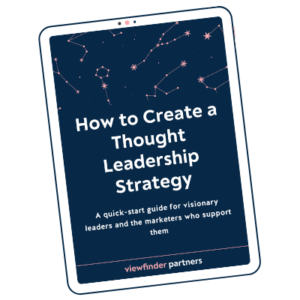This week, I got a pitch for a podcast I produce. I really wanted to like the pitch. I needed a guest for the show, and the pitch was for a person who should have been just right. She works in the right industry, thinks about the same general topics we cover on the show, and she’s asking to be on the show. How could I say no, right?
But the pitch, while relevant, was dreadfully boring. It was written by a PR team, who told me their thought leader could talk about “employee engagement” and “culture.”
You know, really specific stuff like that.
There was no angle. No perspective. No personality. No story. No voice. No strong opinion. Nothing to differentiate the pitch from any other one. And so it didn’t stick. I kept hunting for more interesting ideas, angles, and stories. I said “no.”
And I realized that there’s a lesson here.
B2B is notoriously boring. When we talk about “thought leaders” and “subject-matter experts,” we’re talking about people with professional expertise. Our professional expertise is hard-won over years of work. So we want it to seem important, and, honestly, complicated and maybe a little murky to people on the outside.
But important and complicated ideas are not memorable. They aren’t accessible or buzzy. They don’t stick with us.
The lesson: If we want to be heard, have influence, and get our ideas out there, we need to say something that sticks.
So here’s my action item for today, if you can’t figure out how to communicate your big ideas: Brand your idea. Give it a name. Make it stick.
Here are 3 ways to brand your idea to make it stick.
1. Simplify it.
The easiest way to brand your idea is to get rid of alllll the complexity. This sounds like an obvious solution, but simplifying is really hard for a lot of the experts I’ve worked with. When you know a LOT about a certain topic, you enjoy the complexity, the nuance, and the details. And if your ego is driving, you want everyone else to know just how much you know.
Resist the urge to complicate your ideas. Strip away the extra. Get to the core, quickly.
Ask yourself: If I wrote a book about this, what would the title be? What would make someone grab this off the shelf?
✳️Example: Simon Sinek’s much-loved book is “Start with Why.” That’s a very simple title. You immediately know what he wants you to do. And you remember it. Here’s the boring, complex, B2B version of that book title that I made up: “Understand Your Purpose to Build a Better Company That Lasts and Brings Everyone Along.” The branding matters. The branding makes his simple idea shine.
✳️See also: Stupid-simple podcast titles like “I Made It” from Podia and “How’s Work?” with Esther Perel.
✳️And: Joe Biden’s genius tagline, “Build Back Better.” So simple. So compelling. Makes you want to take action. And extra points for the alliteration.
2. Get specific.
In the pitch example I mentioned above, the problem actually wasn’t that the ideas were too confusing. They were too broad. If the thought leader had gotten specific, I would have had something to grab onto. I wanted her to share her specific take — her unique perspective. I wanted her to stop me in my tracks and make me reconsider old ideas. Instead, she gave me a big vanilla volley and I let it pass right by.
Don’t just tell me that you know about [broad, overarching topic]. Tell me what you think about that topic. Give me your “and, but and also.”
How could you brand your idea to show your specific perspective? Do you have an angle that no one else has considered? Is your idea funky or unexpected? Lead with that!
✳️Example: The best interviews are with people who give you something new to think about, but present their ideas in an approachable way. Here’s a good example. In an interview with Arianna Huffington, Procter & Gamble Chief Legal Officer Deborah Majoras wowed me with her new and branded ideas. Her advice for everyone working from home: take “terrific breaks” and watch out for the “revenge of the introvert.”
3. Lighten up.
To take the boring out of B2B, you have to be willing to play a little bit. Laugh at yourself. Lighten up.
✳️Example: I’m always watching the marketing firm Velocity Partners. Their email subject lines make me laugh out loud, and they’re excellent copywriters. At this point, they’ve earned a strong brand in my head. I think of them as “Smart and funny. Pushing the boundaries. They get it.” Here are some of their recent ideas:
-
A stakeholder through the heart: Why your senior execs are ruining your marketing and what you can do about it
And how about this for a blurb on a LinkedIn post?
“We unashamedly plundered every B2B-shaped nugget we could from one of the world’s hottest tech companies. Here’s what we learned.”
So, let’s start branding! This is the fun part! Branding your ideas is your opportunity to give them some shine. You might even find that branding your ideas forces you to clarify and develop your thinking even further.







